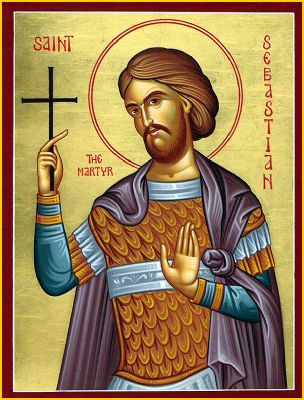|
|||
|---|---|---|---|
| This weekly bulletin insert complements the curriculum published by the Department of Christian Education of the Orthodox Church in America. This and many other Christian Education resources are available at http://dce.oca.org. | |||

The Orthodox Church commemorates a martyr-saint we have in common with the Western Church. Most tourists in Rome, especially religious pilgrims, will visit a church or basilica named for Saint Sebastian, either the one on the Palatine Hill or the earlier fourth-century one built outside the Aurelian Walls. Sebastian, raised in Milan, was an ardent Christian from an early age. Though completely disinclined to military life, he knew that Christians were being persecuted, especially those in military service. He joined the army in about the year 283, intending to comfort and encourage his brothers in the faith. His help was soon needed by two brothers, Marcus and Marcellianus, who had been sentenced to death. Their faith was wavering, both from fear and because of the tearful pleadings of friends that they should not squander their lives. Sebastian gently but eloquently urged them not to exchange heavenly crowns for a longer earthly life. He spoke so powerfully that the jailer and many others who overheard were converted. The Roman governor learned of this and also was told that a man had been cured of gout while being instructed and prepared for baptism. The governor, who suffered greatly from gout, humbly asked the saint to cure him as well. After receiving healing and Christian instruction he not only was baptized with his son Tiburtius, but liberated the Christian prisoners, freed his own slaves and gave up his government position. In the year 286 persecutions intensified. Marcus and Marcellianus, their father Tranquillinus, and Zoe, a woman healed by Sebastian, all were martyred along with many others. Sebastian stayed with the rest of his spiritual children in the city, rather than hiding out in remote places where he would have been safe, and was arrested. Not everyone showed integrity in these difficult days. Young Tiburtius was betrayed to the authorities and beheaded. Sebastian, who was considered the most dangerous of the Christians, was sentenced by Emperor Diocletian to be killed by being shot with arrows. The emperor's Mauretanian archers left Sebastian for dead, but other Christians found him and helped him recover. He still wouldn't hide, but publicly reproached the emperor for cruelty. Furious at seeing him alive, Diocletian ordered him beaten to death with cudgels. Later his abandoned body was secretly buried in catacombs over which a church would one day be built. Saint Sebastian's story, with its elements of fear and betrayal, reminds us that Christians are often imperfect. For example, Scripture tells us that the when Jesus asked the apostles what they had been talking about they were embarrassed to tell Him that they had been discussing "who was the greatest" (Mark 9:34). In Mark's Gospel Jesus reminds us that even simple acts of charity can save imperfect people: "For truly, I say to you, whoever gives you a cup of water to drink because you bear the name of Christ, will by no means lose his reward" (Mark 9: 41). |
|||
